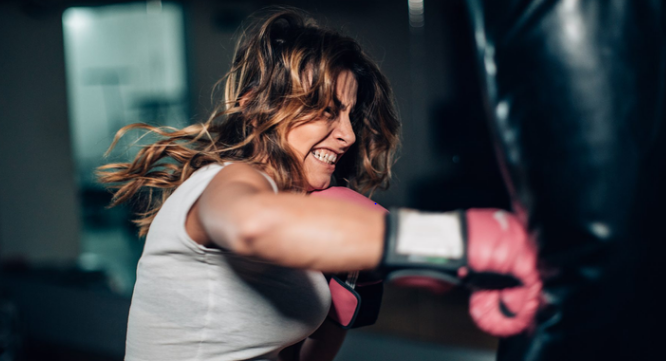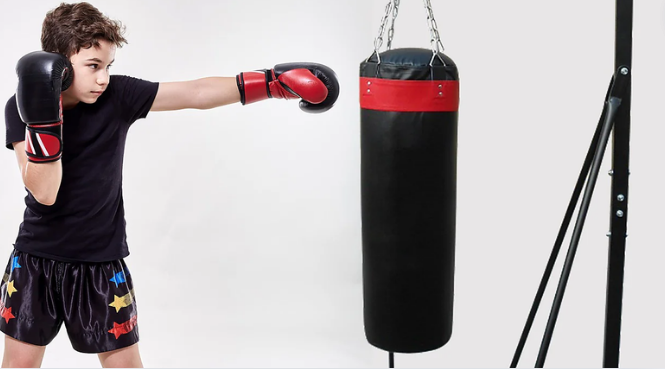Introduction
Unleash the power of your fitness routine with punching bag training! As an experienced fitness enthusiast, I can attest to the incredible benefits of incorporating a punching bag into your workout regimen. From enhanced cardiovascular health to improved stress management, the punching bag is a versatile and highly effective tool that can elevate your fitness journey to new heights.
The Benefits of Punching Bag Training
Punching bag training offers many benefits that can transform your fitness and wellbeing. Here are a portion of the key benefits:
Improved Cardiovascular Health: Punching bag workouts can significantly boost your heart rate, leading to enhanced cardiovascular endurance and improved overall fitness.
Enhanced Muscle Strength and Tone: Punching bag training’s repetitive striking motions and full-body engagement can help build and tone muscle, resulting in a more toned and defined physique.
Stress Relief and Mental WellbeingWellbeing: Punching bag workouts, with their rhythmic and cathartic nature, can be an excellent outlet for releasing pent-up stress and anxiety and promoting better mental health.
Increased Coordination and Balance: Mastering the techniques involved in punching bag training can improve your overall coordination, balance, and agility, which can benefit various aspects of your life.
Boosted Confidence and Self-Discipline: Consistently training with a punching bag can instill confidence and self-discipline, empowering you to push your limits and achieve your fitness goals.

Different Types of Punching Bag
When it comes to punching bag training, there are several types of bags, each with unique characteristics and benefits. Let’s explore the most common options:
Heavy Bag: The classic heavy bag is a large, cylindrical bag typically filled with sand or other dense materials. It’s designed to withstand powerful strikes and is ideal for developing strength, power, and technique.
Speed Bag: The speed bag is a small, round bag suspended from a platform or frame. It’s designed to improve hand-eye coordination, timing, and reflexes through rapid, rhythmic strikes.
Teardrop Bag: The teardrop bag is a smaller, more compact version of the heavy bag, often used for more focused and technical training. It’s great for practicing specific combinations and improving accuracy.
Freestanding Bag: The freestanding bag is a portable and versatile option that can be easily set up and moved around. It’s perfect for those with limited space or who want the flexibility to train in different locations.
Picking the Right Punching Sack for Your WellbeingWellbeing Goals
While choosing a punching sack, considering your particular wellness objectives and preparing needs is fundamental.
The following are a couple of components to recollect:
Bag Size and Weight: Choose a bag that matches your height and strength level. Heavier bags are better suited for developing power, while lighter bags are more suitable for speed and agility training.
Bag Material: The bag’s material can affect resistance and impact. Calfskin or vinyl sacks are sturdy and enduring, while engineered packs might be more reasonable.
Bag Mounting: Depending on the available space in your training area, decide whether you need a freestanding bag or one that can be wall-mounted or ceiling-hung.
Fitness Goals: Assess your fitness objectives, such as improving cardiovascular fitness, building muscle strength, or enhancing coordination, and select a bag that aligns with those goals.
Essential Techniques for Punching Bag Training
Mastering the fundamental techniques is crucial for effective and safe punching bag training. Here are a few basic strategies to zero in on:
Legitimate Position: Keep a fair, shoulder-width position with your weight equitably disseminated on the wads of your feet.
Punching Technique: Learn the correct form for basic punches, such as the jab, cross, hook, and uppercut, ensuring proper hand and wrist alignment.
Footwork and Movement: To improve your agility and evasiveness, incorporate dynamic footwork, such as lateral steps, pivots, and slips.
Defensive Maneuvers: Practice defensive techniques like blocks, parries, and slips to develop your overall defensive skills.
Combination Strikes: Combine various punches and defensive moves to create fluid and effective combination sequences.
Punching Bag Workout Routines for Beginners
If you’re new to punching bag training, start with these beginner-friendly workout routines to build a solid foundation:
Cardio Blast: Alternate between 30 seconds of rapid punches and 30 seconds of active recovery (such as jumping jacks or high knees) for 10-15 minutes.
Strength and Conditioning: Perform 3-4 sets of 10-15 reps of basic punches (jab, cross, hook, uppercut) followed by 30 seconds of plank holds or bodyweight exercises.
Technique Drill: Focus on mastering specific punching techniques, such as 3-5 rounds of 1-minute drills on the bag, with 30-second rest periods in between.
Remember to start with lighter workouts and gradually increase the intensity and duration as you build endurance and confidence.
Advanced Punching Bag Drills for Experienced Fighters
For those with more experience in punching bag training, here are some advanced drills to take your skills to the next level:
Combination Sequences: Perform complex, multi-punch combinations, such as jab-cross-hook-uppercut, emphasizing fluidity and power.
Interval Training: Alternate between high-intensity bursts of rapid strikes and active recovery periods to build cardiovascular endurance and explosive power.
Footwork Drills: Incorporate lateral movements, pivots, and evasive maneuvers while striking the bag to improve your agility and defensive capabilities.
Specialty Bag Drills: Experiment with different types of bags, such as speed and teardrop bags, to refine your timing, accuracy, and hand-eye coordination.
Shadow Boxing: Participants engage in shadow boxing exercises, visualizing and executing advanced techniques and combinations without using a physical bag.

Common Mistakes to Avoid During Punching Bag Training
To ensure safe and effective punching bag training, it’s essential to be aware of and avoid these common mistakes:
Improper Technique: Neglecting proper form and technique can lead to injury and limit the effectiveness of your workouts.
Overtraining: Pushing yourself too hard or fast can result in fatigue, muscle soreness, and an increased risk of injury.
Absence of Warm-up and Chill-off: Skirting legitimate warm-up and chill-off schedules can leave you helpless against strains and other wounds.
Incorrect Bag Placement: Positioning the bag too close or too far can make it difficult to execute techniques effectively and increase the risk of injury.
Inadequate Protective Gear: Shoulder hand wraps, gloves, and other protective equipment can avoid exposing your wrists to potential harm.
Equipment and Gear for Effective Punching Bag Workouts
Having the proper hardware and gear is fundamental to guarantee a protected and valuable punching sack preparation experience. Here are the essential items to consider:
Punching Bag: Choose a high-quality bag that suits your size, strength, and training goals.
Hand Wraps: Appropriately wrapping your hands is significant to safeguard your wrists and knuckles during influence.
Boxing Gloves: Invest in a pair of well-fitting, high-quality gloves to cushion your hands and absorb the impact of your strikes.
Mouthguard: Wearing a mouthguard can help protect your teeth and jaw in case of accidental impacts.
Protective Headgear: For more advanced training or sparring, consider using a protective headgear to safeguard your head.
Exercise Clothing: Wear an agreeable, breathable, and adaptable dress that allows a full range of movement during your exercises.
Incorporating Punching Bag Training into Your Fitness Routine
Integrating punching bag training into your overall fitness routine can be a game-changer. Here are some tips to help you seamlessly incorporate it:
Establish a Consistent Schedule: Set aside dedicated time in your weekly routine for punching bag workouts, ensuring they become a consistent part of your fitness regimen.
Vary Your Workouts: Use cardio-focused, strength-building, and technique-driven punching bag sessions to keep your body challenged and engaged.
Cross-Train: To achieve a well-rounded fitness approach, complement your punching bag training with other forms of exercise, such as strength training, plyometrics, or high-intensity interval training.

Monitor and Adjust:
- Regularly assess your progress.
- Adjust the intensity and duration of your punching bag workouts.
- Adapt your routine to ensure continuous improvement and prevent plateaus.
Listen to Your Body: Pay attention to any signs of fatigue or discomfort. Be willing to modify or take rest days to prevent injury and support your recovery.
Punching Bag Training for Stress Relief and Mental WellbeingWellbeing
In addition to its physical benefits, punching bag training can profoundly impact mental health and wellbeing. Its rhythmic and cathartic nature can be an excellent outlet for releasing pent-up stress, anxiety, and frustration.
As you immerse yourself in the focused, high-intensity movements, your mind will become more present and grounded, allowing you to let go of the day’s worries. The sense of empowerment and accomplishment of mastering new techniques can also boost your self-confidence and overall mood.
Moreover, the social aspect of training with others can foster community and camaraderie, further contributing to your mental and emotional wellbeing.
Are you prepared to elevate your wellness process? Discover the transformative power of punching bag training and unlock your full potential. Contact us today to learn more about our comprehensive training programs and how we can help you achieve your fitness goals.
Conclusion
Punching bag training is a versatile and highly effective way to elevate your fitness routine and unleash your full potential. Incorporating this dynamic workout into your regimen will bring many benefits, from improved cardiovascular health and muscle strength to enhanced stress relief and mental wellbeing.
Whether you’re a beginner or an experienced fighter, there’s a punching bag and a training approach that can cater to your specific needs and goals. By mastering the essential techniques, selecting the right equipment, and integrating punching bag training into your overall fitness plan, you’ll embark on a transformative journey that will leave you feeling more grounded, sure, and stronger than ever in recent memory. So, what are you waiting for? Embrace the power of punching bag training and unlock a new level of fitness and wellbeing today!



